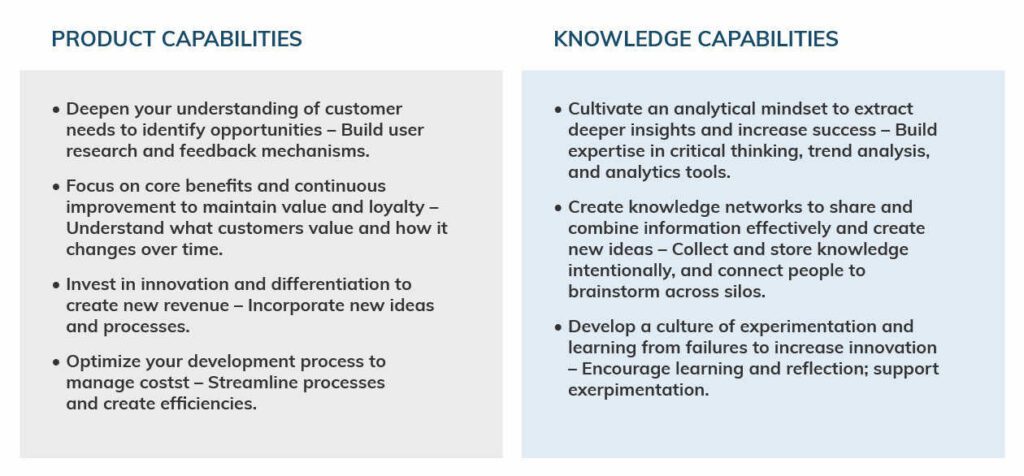Both product and knowledge capability building are essential to your company’s survival in the digital age. In this blog, we explore what these capabilities are and why you need to develop them both for long-term growth.
Research in Motion (RIM), the precursor to BlackBerry Limited, pioneered email delivery on mobile devices in the late 1990s and early 2000s. For the first time, businesspeople could receive and respond to email messages whenever and wherever they wanted. By 2011, more than 85 million people were using BlackBerry devices.
But then came Android and iPhone devices. Their touch screens initially appealed largely to young people, but BlackBerry failed to understand that business people wanted easier-to-navigate interfaces and smoother operating systems, too. BlackBerry scrambled to release its own touchscreen phone, but the devices were plagued with technical problems.
BlackBerry’s story demonstrates what can happen when product capability — a company’s capacity to create an excellent product — does not tie to its knowledge capability — its capacity to gather data and gain insights about market and customer trends. In BlackBerry’s case, their overinvestment in creating the keyboard-based product they knew rather than also investing in their knowledge capability. The result: When change surprised them, they lacked the resources to create a competitive product.
Developing both product and knowledge capabilities is essential for businesses that want to succeed in the digital age. Together, they can create powerful synergies that will lead to sustainable competitive advantage, help your organization grow, and provide the resilience you need to navigate lean times successfully. Perhaps Jack Welch said it best: “An organization’s ability to learn, and translate that learning into action, is the ultimate competitive advantage.”
A Closer Look at Product and Knowledge Capabilities
In this blog, “product” refers to the tangible and intangible offerings that an organization provides to its customers, whether those customers are internal or external. Such products do not have to require an exchange for money or another benefit. For example, a nonprofit agency’s product may be to deliver healthy food to populations who need it.
Some core capabilities required to deliver any product are the ability to:
- Identify and understand customer needs
- Develop innovative products and features
- Launch products quickly and efficiently
- Deliver value consistently
- Manage product lifecycles
- Drive differentiated experiences
Many companies have a strong product focus but are just now catching up to the need to move more quickly and deepen their knowledge capabilities. They have made major investments in big data, and now AI, but knowledge capabilities go beyond the ability to capture, store and retrieve data. They also include transforming data into actionable insights. These capabilities include the ability to:
- Capture, store and share knowledge effectively
- Analyze knowledge for insights and understanding
- Use knowledge to improve performance
- Manage data quality and standards over time
- Provide knowledge as a product
To see how these capabilities can work together, let’s explore a more successful business example that we are probably all familiar with: your local craft brewery.
Capability Development and the Rise of Craft Soda
Craft brewing experienced a huge boom over the past 30 years, and it seemed like a new one was popping up every month. To stand out and create customer stickiness, many breweries explored options like opening tasting rooms (which became social centers), creating new and unusual flavor profiles, and distributing online to expand their customer base.
But even with these efforts, many breweries found the market crowded and competitive, and they struggled to find new ways to break through the noise. However, understanding their opportunities enabled some breweries to find new markets using many of the core capabilities they already had and developing some new ones to complement them.
One example of using knowledge capability came from one core industry insight. According to a beverage industry publication, “Roughly 1 in 7 on-premise patrons drink non-alcoholic alternatives, rising to 25 percent for customers under the age of 35. Nearly half of non-alcoholic drinkers consume both alcoholic and non-alcoholic drinks when at on-premise serving spots.” This insight demonstrated the potential of offering non-alcoholic alternatives to customers who were already engaged in the experience. One potential product was craft soda.
Additional knowledge capabilities provided some specific understanding of the opportunity. Further analysis highlighted common market drivers between the beer and soda markets:
- Both markets were growing, providing longer-term revenue opportunities.
- Consumers in both markets wanted to see the use of high-quality, natural ingredients in their products and new and unusual flavor combinations.
- Sustainable processes and packaging mattered for craft brewing customers.
- Online and direct-to-consumer channels mattered for both.
Some craft brewers used these additional insights and their understanding of their product capabilities to identify underlying common capabilities to use:
- Manufacturing equipment
- Ingredient sourcing
- Production knowledge
- Branding and marketing
- Customer base
In addition, they identified where new knowledge was needed to take advantage of their product capabilities and enable growth:
- Market opportunities
- Product costs
- Distribution channels
- Competitive landscape
- Customer preferences
Beyond craft soda, some brewers used their product and knowledge capabilities to identify additional opportunities, such as craft mocktails and mixers. Not only did this enable growth, but it also provided resilience during the unexpected downturn driven by the COVID-19 epidemic: Several breweries (and distilleries) turned to making hand sanitizer at a time when gathering for beverages was not possible, but demand for personal protection was high.
Steps Toward Building Capabilities
Our craft brewery example offers two key takeaways:
- It’s not enough to produce products well – you need to understand what will deliver value, to who, and how.
- Developing knowledge capabilities in conjunction with your product capabilities drives competitive advantage and organizational adaptability.
How can you do this in your business? Fortunately, any industry can take a few practical steps to further develop product and knowledge capabilities:
As you evaluate your current product and knowledge capabilities, you can start asking yourself the tough questions: what can you learn from what you already do to give you an advantage in the future? Where do you need to invest further?
Conclusion
In today’s fast-changing business environment, you must be ready to pivot when conditions change, or you receive new information to sustain your advantage. Understanding where opportunities lie and assessing those opportunities in the context of your product capabilities enables you to respond more effectively and rapidly.
Focusing on your product capabilities alone may drive you to over-invest in what you already know and do, and having great knowledge capabilities but not the product capabilities to execute against may make an opportunity too challenging or expensive to take on. Using both together puts you in the best position to move forward successfully.
Whether you’re embarking on a transformation journey or optimizing operations, our Strategy Alignment and Architecture experts can guide you with capability modeling and design, process architecture, organization design and role definition, shared services strategy and design, and technology and enterprise architecture. Get Started



